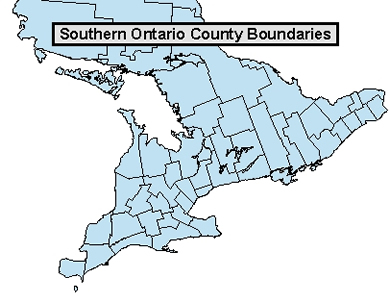I find your constant characterization of the political structure aspect of the topic (the only aspect there is actually) as "gobbledygook", and putting all your eggs into this imaginary, intrinsic "sense of place" aspect very strange indeed. And then you claim we all feel this way. Sorry, but I don't perceive it this way at all. And stop blaming it on me being some kind of "student" of some strange cult. I'm probably as old...if not older than you, and have experienced both county life as well as the Toronto experience.
Perhaps I don't feel a sense of Toronto as "part" of York County for the simple reason that it isn't. And looking at a map of York County that depicts the City of Toronto on it doesn't compel me to change that.
Sometimes a cigar is just a cigar...no?
But as a closing statement on this, I don't think you are "wrong" to feel differently about it.
Well, maybe in the
absolute sense you may be right, in that the whole sense-of-place thing was always overrated, that most people
at large didn't give a whiz about city vs county vs whatever identity. They were "places", that's it--places they lived in, places they drove through, etc. Just like the old King's Highway network was "roads", that's it--nothing inherently mythic or "defining matrix" about those numbered red-as-opposed-to-grey lines on the map, especially once the erstwhile grey lines came to be as "travellable" as the red lines even if they had county/regional flowerpot signs rather than King's Highway shields. To plain, ordinary, Ontarioscape-philistine Joe Blows, none of that mattered--and the evolution of political structure, much like the evolution of highway/road structure, has reflected that indifference.
So, from the Ontario Road Maps site, take 1971

The "coloured county" prime time--Metro's separate, but more as a unitary municipality than anything; otherwise, no different from the "over 10000 population" yellowness of Barrie, Aurora, Richmond Hill. And brand-new York Region's tokenly depicted; but otherwise, the pre-regional conditions within are maintained. As the official road map, this was pretty much the "public face" of Ontario, geographically speaking--an era when it was all about counties and the places within, places with symbols indicating population size (and in the index, they gave the populations--yes, it was deemed "officially" meaningful). And, this is when cities/towns/villages/police villages were cities/towns/villages/police villages, they weren't hyperactively subsumed into big blocs of municipality (well, actually, they secretly *were* at this moment, in York--you couldn't tell from this map that Markham was now a big blob of 20/30/40 thousand or whatever it was at that moment). And there was a certain geographic sensuality about this pattern: these weren't just dry administrative abstractions--this was an era when the sense of place(s) was still quite "nucleated" in a pre-sprawl fashion: a pattern that would have made Ebenezer Howard happy, I suppose.
Then, compare to 1999...
...now we're in the aimlessness of the post-nucleated era, where there's lots of dots indicating "places", but scarcely any hint of substance (other than grade of font) beyond that; where county/regional boundaries have degenerated to grey lines that are scarcely much thicker than whatever token municipal boundaries within; where "urbanity" is but blobs of orange (and populations? who cares); all in all, a dreary demonstration of how none of that cartographical Ontarioscape stuff that seemed to "matter" in 1971 much mattered anymore. Including the official Ontario map itself, which in a MapArt era on the verge of GPS universality came across as a skimpy autopilot anachronism. (Though one thing I'll say even on behalf of the latter map: if "city" were so separate from "county" as it is in Virginia, then Guelph would have a thick grey line around it, not a thin one.)
It's perhaps in this latter era that such excessively "administrative" views of political structure are conditioned, i.e. the inherent geographic sensuality of the 1971 map is, to the freshcutgrass/howl crowd (and needless to say, those younger), a grandfatherly anachronism.
However, it
may plug back into the thread, if we read into any real-or-hypothetical deamalgamation sentiment (maybe more so in the late 90s than now, i.e. the scorched-earth Sewellite greybeard-and-biddy wing of the C4LD bunch)...maybe it
is a longing for that 1971-and-even-earlier era, taken a few Jane Jacobite steps further to the point where Megacity decomposes into a flurry of reconstituted Mimicos and Westons and Leasides and municipalities-that-never-were. A municipal" re-nucleation": Toronto as a network of Gousha-esque place-indicators. (Heck, one net result of Montreal's amalgamation-and-then-deamalgamation is that even what's left of Montreal has mentally decomposed to the point where "borough identification" is almost stronger relative to "unitary municipal identification" than it's ever been.)










